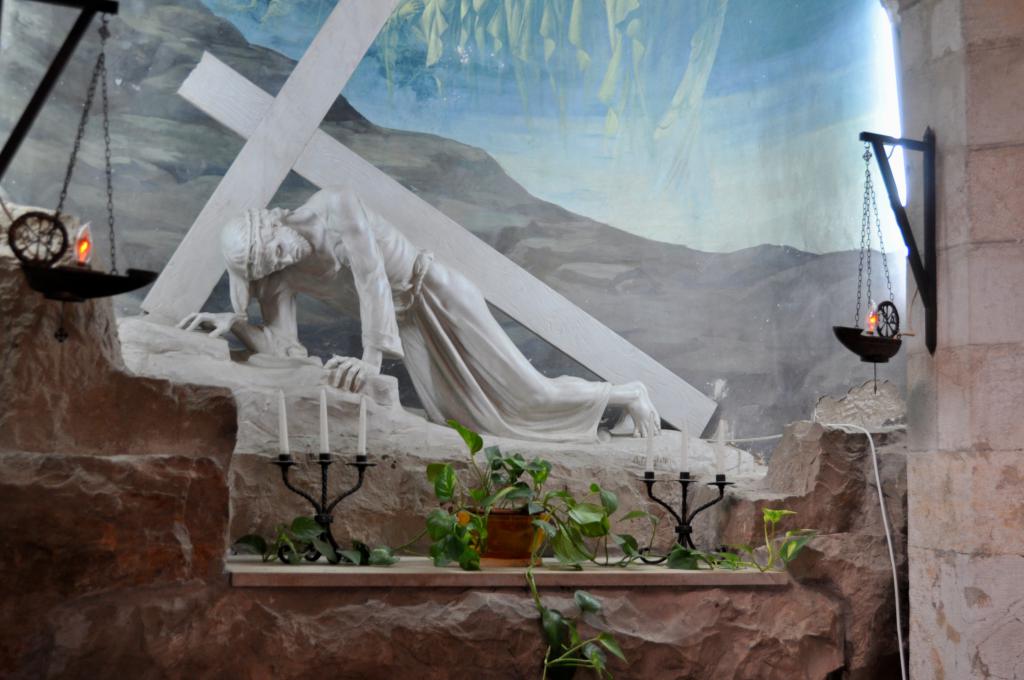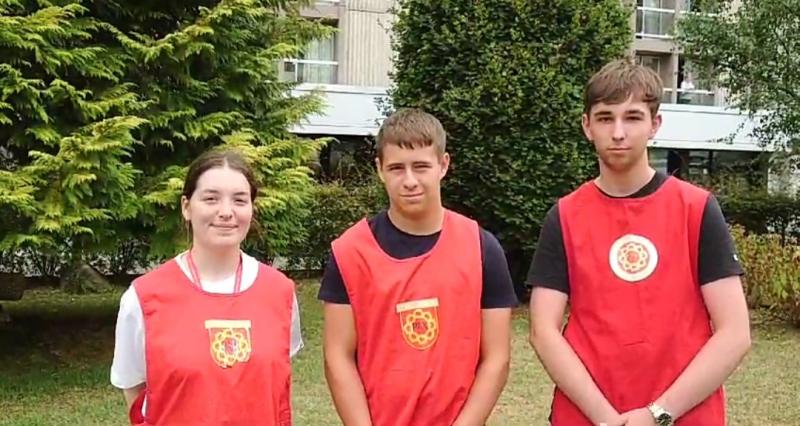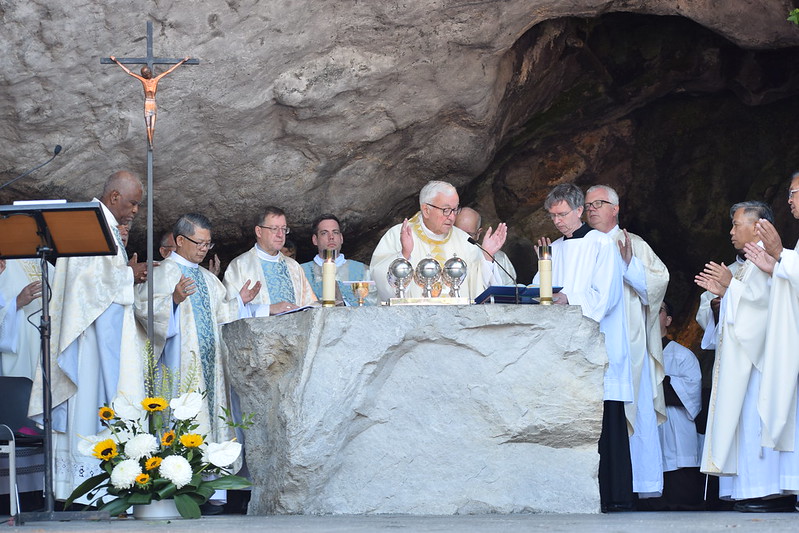Today we were fortunate to experience Jerusalem entirely on foot, walking in the footsteps of Christ through his Passion. We began our day with Mass early in the morning in the Chapel of the Crusaders in the Church of the Holy Sepulchre.
In his homily, Fr John set the scene for Jesus’ crucifixion, recognising that in the Holy Sepulchre it is difficult to imagine what the site would have looked like in Jesus’ time. The original city walls of Jerusalem did not include the site of Jesus’ crucifixion and his tomb, over which the Holy Sepulchre was built. Jesus’ crucifixion took place in a disused quarry where they crucified criminals and left their bodies as an example, and to be eaten by the animals. This brought Jesus to the lowest level, amongst the murders and robbers. Tombs were cut into the edge of the quarry, and this was where Jesus was laid by Joseph of Arimathea. The site became known as Golgotha, meaning skull, because a large stone there resembled a skull.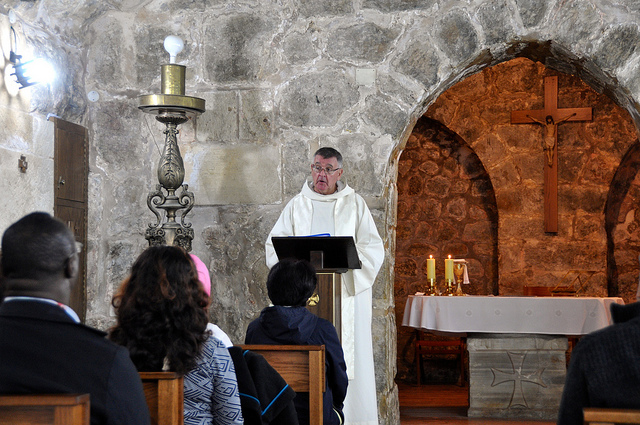
A church was first built on the site by the Emperor Constantine and his mother Helen, which was four times the size as the current church. Many years were spent carving away the other tombs around Jesus’ tomb and, following the destruction of the original church, there is only a small portion of the tomb remaining. The church is now occupied by six different Christian denominations: the Roman Catholics, the Greek Orthodox, the Armenian Apostolics, who are the primary custodians, and the Coptic Orthodox, the Syriac Orthodox and the Ethiopian Orthodox.
Fr John went on to consider the importance of Christ’s resurrection for us, saying: ‘We do not have an absentee Lord. He is risen and with us until the end of time.’ The Paschal Candle that is lit at Easter represents the light of Christ in our lives as a natural light that illuminates all things. It shines for us in times of joy and sorrow.
After Mass, the group descended down to the Chapel of St Helena, part of the Armenian section of the Holy Sepulchre. Below this chapel is the spot where Helena found the cross on which Christ was crucified, along with the two others who were crucified with him. It is likely that the crosses were discarded of quickly by the Roman officials before the Sabbath, and were left untouched for many years.
Our guide Rami explained that we traditionally depict the crucifix as a tall structure, but the reality was that they were only the same size as a man, so that people could look those being crucified in the eyes, and so their bodies were easily accessible to animals. Jesus was saved from this fate because the Roman officials wanted to remove the bodies before the Sabbath began.
Leaving the Holy Sepulchre, we walked down through the streets and market of Jerusalem to St Anne’s church and the archaeological remains of the Pools of Bethesda. St Anne’s church is built over the site that is traditionally thought to have been the birthplace of Mary. As we learnt first hand, it is known for its wonderful acoustic, prompting many groups to break into joyful song which echoes out of the church into the surrounding courtyard. 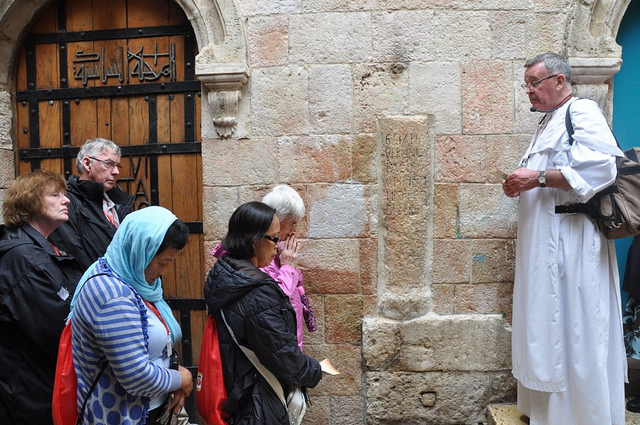
The Pools of Bethesda supplied the Temple with water and were where the animals were washed before being sacrificed. It was at these pools that Jesus healed a paralysed man. Believing that the angel of the Lord touched the water in the pools, sick people came to be immersed in the pools hoping for healing. A paralysed man was unable to reach the pools as he had no one to help lower him in, at which point Jesus said to him: ‘Take up your bed and walk’ (Jn 5.11), and the man was healed.
Nearby is the site of Lithostrotos, or Gabbatha, where Jesus was sentenced to death. At the time of Jesus, this was the Antonia Fortress, the centre of the Roman administration in Jerusalem. Carvings are still visible on the stone floor where Roman soldiers played dice games like those in the gospels when the soldiers played for the piece of cloth worn by Christ. This spot marks the beginning of the Via Dolorosa, which follows Christ’s final journey from Gabbatha to Calvary.
After lunch we divided into two groups to walk the Via Dolorosa, the Way of the Cross. Despite the often cramped path, and the hustle and bustle of shoppers and traders around us, the pilgrims found it particularly moving to complete the Stations of the Cross on the actual route that Jesus took. For Jesus, as it was for us, it would have been an ordinary day in the life of the city. People around us went about their business, occasionally glancing over to see what was happening, but otherwise took little notice of the small groups praying and singing through the busy streets. Finishing as a whole group together on the roof of the Holy Sepulchre was a particularly moving moment for all.
For photos from today, please click here.
